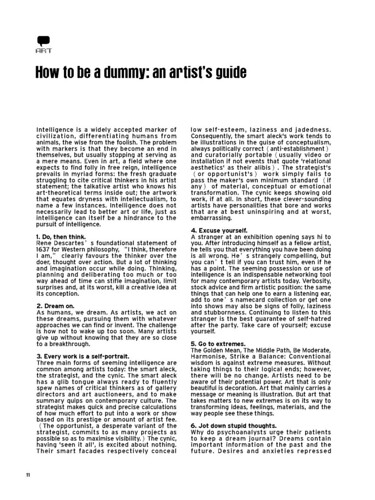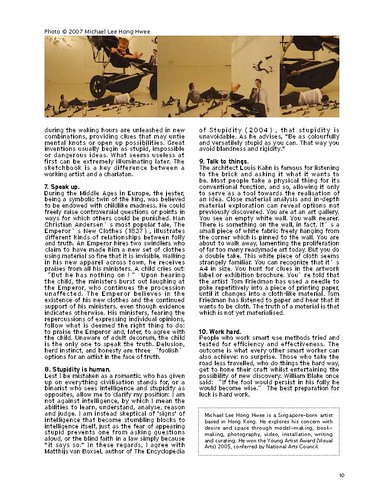Media / Section: Meta / ART
Date: June 2008 issue
Title: How to be a dummy: an artist's guide
Author: Michael Lee Hong Hwee
City: Hong Kong


Intelligence is a widely accepted marker of civilization, differentiating humans from animals, the wise from the foolish. The problem with markers is that they become an end in themselves, but usually stopping at serving as a mere means. Even in art, a field where one expects to find folly in free reign, intelligence prevails in myriad forms: the fresh graduate struggling to cite critical thinkers in his artist statement; the talkative artist who knows his art-theoretical terms inside out; the artwork that equates dryness with intellectualism, to name a few instances. Intelligence does not necessarily lead to better art or life, just as intelligence can itself be a hindrance to the pursuit of intelligence.
1. Do, then think.
Rene Descartes’s foundational statement of 1637 for Western philosophy, “I think, therefore I am,” clearly favours the thinker over the doer, thought over action. But a lot of thinking and imagination occur while doing. Thinking, planning and deliberating too much or too way ahead of time can stifle imagination, limit surprises and, at its worst, kill a creative idea at its conception.
2. Dream on.
As humans, we dream. As artists, we act on these dreams, pursuing them with whatever approaches we can find or invent. The challenge is how not to wake up too soon. Many artists give up without knowing that they are so close to a breakthrough.
3. Every work is a self-portrait.
Three main forms of seeming intelligence are common among artists today: the smart aleck, the strategist, and the cynic. The smart aleck has a glib tongue always ready to fluently spew names of critical thinkers as of gallery directors and art auctioneers, and to make summary quips on contemporary culture. The strategist makes quick and precise calculations of how much effort to put into a work or show based on its prestige or amount of artist fee. (The opportunist, a desperate variant of the strategist, commits to as many projects as possible so as to maximise visibility.) The cynic, having 'seen it all', is excited about nothing. Their smart facades respectively conceal low self-esteem, laziness and jadedness. Consequently, the smart aleck's work tends to be illustrations in the guise of conceptualism, always politically correct (anti-establishment) and curatorially portable (usually video or installation if not events that quote 'relational aesthetics' as their alibis). The strategist's (or opportunist's) work simply fails to pass the maker's own minimum standard (if any) of material, conceptual or emotional transformation. The cynic keeps showing old work, if at all. In short, these clever-sounding artists have personalities that bore and works that are at best uninspiring and at worst, embarrassing.
4. Excuse yourself.
A stranger at an exhibition opening says hi to you. After introducing himself as a fellow artist, he tells you that everything you have been doing is all wrong. He’s strangely compelling, but you can’t tell if you can trust him. Even if he has a point. The seeming possession or use of intelligence is an indispensable networking tool for many contemporary artists today. Verbosity, stock advice and firm artistic position: The same things that can help earn one a listening ear, add to one’s namecard collection or get one into shows, may also be signs of folly, laziness and stubbornness. Continuing to listen to this stranger is the best guarantee of self-hatred after the party. Take care of yourself; excuse yourself.
5. Go to extremes.
The Golden Mean, The Middle Path, Be Moderate, Harmonise, Strike a Balance: Conventional wisdom is against extreme measures. Without taking things to their logical ends, however, there will be no change. Artists need to be aware of their potential power. Art that is only beautiful is decoration. Art that mainly carries a message or meaning is illustration. But art that takes matters to new extremes is on its way to transforming ideas, feelings, materials, and the way people see these things.
6. Jot down stupid thoughts.
Why do psychoanalysts urge their patients to keep a dream journal? Dreams contain important information of the past and the future. Desires and anxieties repressed during the waking hours are unleashed in new combinations, providing clues that may untie mental knots or open up possibilities. Great inventions usually begin as stupid, impossible or dangerous ideas. What seems useless at first can be extremely illuminating later. The sketchbook is a key difference between a working artist and a charlatan.
7. Speak up.
During the Middle Ages in Europe, the jester, being a symbolic twin of the king, was believed to be endowed with childlike madness. He could freely raise controversial questions or points in ways for which others could be punished. Han Christian Andersen’s most popular tale, The Emperor’s New Clothes (1837), illustrates different kinds of relationships between folly and truth. An Emperor hires two swindlers who claim to have made him a new set of clothes using material so fine that it is invisible. Walking in his new apparel across town, he receives praises from all his ministers. A child cries out: “But he has nothing on!” Upon hearing the child, the ministers burst out laughing at the Emperor, who continues the procession unaffected. The Emperor believes in the existence of his new clothes and the continued support of his ministers, even though evidence indicates otherwise. His ministers, fearing the repercussions of expressing individual opinions, follow what is deemed the right thing to do: to praise the Emperor and, later, to agree with the child. Unaware of adult decorum, the child is the only one to speak the truth. Delusion, herd instinct, and honesty are three ‘foolish’ options for an artist in the face of truth.
8. Stupidity is human.
Lest I be mistaken as a romantic who has given up on everything civilisation stands for, or a binarist who sees intelligence and stupidity as opposites, allow me to clarify my position: I am not against intelligence, by which I mean the abilities to learn, understand, analyse, reason and judge. I am instead skeptical of 'signs' of intelligence that become stumbling blocks to intelligence itself, just as the fear of appearing stupid prevents one from asking questions aloud, or the blind faith in a law simply because "it says so." In these regards, I agree with Matthijs van Boxsel, author of The Encyclopaedia of Stupidity (2004), that stupidity is unavoidable. As he advises, "Be as colourfully and versatilely stupid as you can. That way you avoid blandness and rigidity."
9. Talk to things.
The architect Louis Kahn is famous for listening to the brick and asking it what it wants to be. Most people take a physical thing for its conventional function, and so, allowing it only to serve as a tool towards the realisation of an idea. Close material analysis and in-depth material exploration can reveal options not previously discovered. You are at an art gallery. You see an empty white wall. You walk nearer. There is something on the wall, in fact. It’s a small piece of white fabric freely hanging from the corner which is pinned to the wall. You are about to walk away, lamenting the proliferation of far too many readymade art today. But you do a double take. This white piece of cloth seems strangely familiar. You can recognize that it’s A4 in size. You hunt for clues in the artwork label or exhibition brochure. You’re told that the artist Tom Friedman has used a needle to poke repetitively into a piece of printing paper, until it changes into a cloth-like material. Tom Friedman has listened to paper and hear that it wants to be cloth. The truth of a material is that which is not yet materialised.
10. Work hard.
People who work smart use methods tried and tested for efficiency and effectiveness. The outcome is what every other smart worker can also achieve: no surprise. Those who take the road less travelled, who do things the hard way, get to hone their craft whilst entertaining the possibility of new discovery. William Blake once said: “If the fool would persist in his folly he would become wise.” The best preparation for luck is hard work.
No comments:
Post a Comment